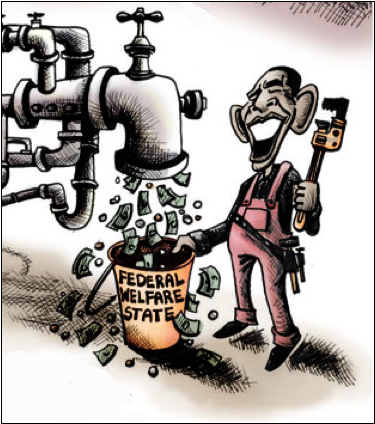On September 4, the Service Employees International Union (SEIU) and Fast Food Forward promised to shut down fast food joints across America in their Fight for $15 campaign. The groups propose increasing the minimum wage nationwide to $15 an hour from its current $7.25 level.
The groups tout the increase as the means to lift millions of Americans out of poverty. But will it?
The question is: Is the malady of poverty caused by low wages, or not enough jobs?
Since 2007, the number of Americans collecting food stamps has increased sharply from 26.3 million to 46.2 million according to the U.S. Department of Agriculture — a telling measure of the growing welfare state in the current recession.
That represents 22 million households. Of those, approximately 29 percent, or 6.4 million households in the Supplemental Nutrition Assistance Program (SNAP) make $1000 or more on a gross monthly basis ($7.25 x 35 x 4), indicating a likelihood full-time work is being completed.
The other 71 percent, or 15.6 million households, made less than that, including 4.5 million that did not make anything at all on a gross basis, indicating part-time work or no work at all.
Therefore, higher wages would not help those households per se, since quite simply, not enough hours are being worked to get out of poverty. Eliminating wages as the cause, then, the problem can only be there are not enough full-time jobs to be had.
In other words, the recession and the loss of millions of jobs drove 20 million new individuals onto the welfare rolls. The way out is to create new, full-time jobs. The amount of the minimum wage is a lot less interesting to somebody who cannot even find work.
But lest there is any doubt, let’s test the idea that increasing minimum wages pulls people out of poverty. We’ll take states that have increased the minimum wage in response to the recession and compare them to states that have not.
Food stamp recipients actually peaked in 2013 at 47.6 million, and appear to be subsiding slightly this year. If the wage hypothesis is correct, then, we might expect to see accelerated dropping off the welfare rolls in those states that are forcing minimum wage increases.
But we don’t. Take California, where the minimum wage is $9 and set to rise to $10 starting in 2016. It actually saw a 6 percent increase in food stamp recipients to 4.4 million in the past twelve months according to the Department of Agriculture, bucking the national trend.
Texas, in comparison, has not raised the minimum wage, which remains at $7.25. Yet, somehow, 295,000 were removed from the welfare rolls to 3.8 million, a 4.9 percent drop.
That’s actually a faster drop off than New York where the minimum wage was raised to $8 an hour the beginning of this year, and will increase to $8.75 in January, and to $9 in 2016.
Yet, only 92,000 have been taken off food stamps, a 2.9 percent drop, to 3.1 million. That is about the same drop as the national average of 2.6 percent.
In fact, of the 18 states with a $7.25 minimum wage and simultaneously are not planning any increases, just one had any increase at all in food stamp recipients in the past twelve months, Pennsylvania. And then, only just slightly, by 0.3 percent.
Of the remaining 32 states, 25 also showed decreases in food stamp enrollment. The exceptions were California, Colorado, Connecticut, Hawaii, Maryland, Nevada, and New Jersey.
So, there appears to be little correlation between higher minimum wages and lower welfare participation. Instead, employment and economic growth seem to have a much greater impact.
It is as Ronald Reagan once suggested, that “the best social program is a job.” Forget the minimum wage, it’s time to grow the economy.
Robert Romano is the senior editor of Americans for Limited Government.







